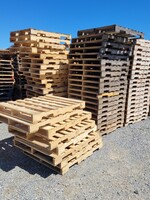- 844-413-0111
- Contact Us
- Member Login
- Join the Revolution !!!


Heat Treated Pallets 48 x 40 4 Way Grade A Pallets
Adopted from Gruber PalletsGruber Pallets
The heat-treating process for pallets, crates, or wood pieces is intended to kill any living organism in the material before export. We will discuss when a pallet should be heat treated, how a pallet should be heat treated, what heat treat stamp marks mean, and some cautions to keep in mind when considering heat treating for export. Definitions IPPC: The International Plant Protection Convention is a resolution created by the Food and Agriculture Organization with the intended aim to establish global standards for plant health. The part of this resolution that pertains to pallets is referred to as ISPM-15. ISPM-15: This is the set of regulations that specifically refer to the standards that govern wood greater than 6millimeters that needs to be heat treated when shipping products to different countries What can be heat treated? Any kind of wood can be heat treated: new, recycled, reused, repaired, single pieces, bundles – all can be treated, but all must be stamped with the corresponding stamp. Why do you need heat treated pallets? The goal of heat treating is to kill bugs and any living organisms so that they won't be given a free international cruise or flight, bringing their sicknesses and diseases with them. Heat treating does not increase the strength or durability of the pallet, it only protects it from bugs. Exemptions Anything 6mm or less Any wood that has been processed in a way that kills pests, like a cigar or wine box Any type of wood that uses glue, veneer, or processed strand board Previously heat treated pallet that has not been repaired, remanufactured, or altered in any way with a valid certification stamp Corrugate, plastic, other non wood items Process Both new pallets and recycled pallets need to be appropriately debarked. Small isolated pieces of bark are allowed if they are less than 3cm wide or with total surface area less than 50mm, which is about the size of a credit card. After a pallet, crate, or dunnage piece has been appropriately debarked, it then enters the heat treater to be heated to 56 Celsius 132.8 Farenheit for 30 minutes. Then and only then can the heat treat stamp be applied. If no structural changes are made to the pallet, the pallet should be able to retain their heat treat status indefinitely. Stamp elements Wheat stamp: This signifies compliance with the IPPC, and will appear to the left of the rest of the information Country of origin: The country code is always 2 letters Producer / treatment provider: this is a combination of digits and or letters that uniquely identify the producer Treatment Code: This is either an "HT" or "MB" marking on the material signifying whether or not the it was heat treated or methyl bromide treated Agency: In the US, the inspection agency is also included in the stamp information For each stamp to be compliant for export, It must be: Durable, Legible, Visible when in use with no aids, and stamped with black ink, because red or orange are often used to signify a harmful product type If the mark does not meet all of these criteria, the packaging item may be subject to confiscation by export authorities. Alternative methods for export Fumigation Fumigation using methyl bromide is the only other way to export wood without changing the composition of the pallet. With fumigation, the pallet is confined in a gas chamber for anywhere from 4-24 hours to soak in all of the gaseous methyl bromide. The other way to export is to use a substance that made or processed in a way that eliminates the opportunity for life growth in the pallet. Some examples of this would be plastic, plywood, particle board, OSB, strand board, corrugate, to name a few. Cautions Some pallet companies have been caught with expired or suspended heat treating licenses, so if you have any questions or suspicions about a particular company and their heat-treating process, be sure to get a copy of the company's heat treat certificate issued by their inspection agency. That way, the agency can confirm or deny the validity of the questionable heat-treating process. If a company is hesitant or slow to release their certification, something may be going awry. You might find some pieces that have the letters "HT" stamped on them, but if they do not have the complete mark like we mentioned before, they are not legally exportable in their current state. Summary When looking to export a product, heat treating is a great way to go. There are regulations to what is allowed to be heat-treated, and be sure your packaging company is following the rules that are in place. Once that homework is finished with the documentation in place, happy exporting!

.png)